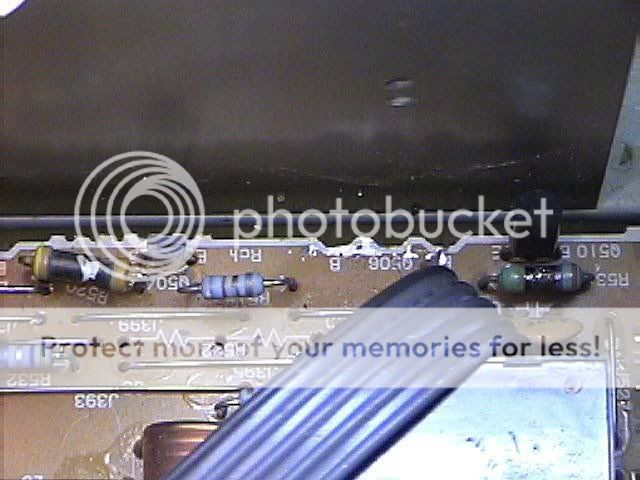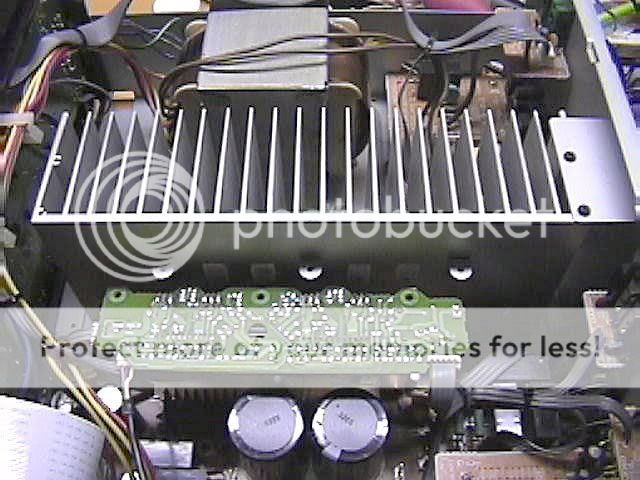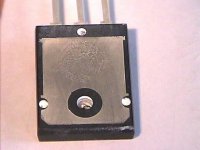I replaced the output transistors in an amp several weeks ago
and they are out again. I noticed a circular rough surface on the
back of one of them when I removed it (see pic). I’m thinking that
there wasn’t adequate contact between the device and the sink.
What do you think? The device is an MJL21194.
Thanks
and they are out again. I noticed a circular rough surface on the
back of one of them when I removed it (see pic). I’m thinking that
there wasn’t adequate contact between the device and the sink.
What do you think? The device is an MJL21194.
Thanks
Attachments
Hi glen65,
Looks like too much grease, but not a transistor killer normally. Did you use new mica insulators?
The other questions would target the driver and bias circuits, also the speaker load. I have seen speaker leads that run into walls that develop intermittent shorts.
When you did this repair, did you check the bias current? Was the current stable with time? Is there enough air flow where it was mounted. What was happening just before the failure?
Make and model number?
Many questons.
-Chris
Looks like too much grease, but not a transistor killer normally. Did you use new mica insulators?
The other questions would target the driver and bias circuits, also the speaker load. I have seen speaker leads that run into walls that develop intermittent shorts.
When you did this repair, did you check the bias current? Was the current stable with time? Is there enough air flow where it was mounted. What was happening just before the failure?
Make and model number?
Many questons.
-Chris
yeah, the words I was searching my mind for.mica insulators
What’s the make and model?”
It’s an Onkyo ASV610PRO integrated amp.
“Did you use mica insulators?”
Yes I used mica insulators,
I just pulled the insulator off of the heat sink and it looked
like there was very little if any grease on that side. I know I
greased it, What was there looked pretty runny almost like water
instead of white. I just purchased a new tube of GC brand heat sink compound before I worked on this unit. It seems to be quite a bit more on the runny side than the last stuff I bought which was the same brand.
“Did you check the bias current?”
I made all adjustments according to the service manual.
The adjustments were pretty touchy but once a had them
set they seemed to be stable. Their using a cheap single turn
pot. I think that this time I will replace them with a multi turn pot
to make the adjustments a bit more manageable.
“Is there enough air flow where it was mounted?”
Yes,
There was nothing sitting on top of the amp to restrict air
flow.
Here are a couple of pic that show the damage.
The driver IC is a UPC1342V which I am having quite a time
trying to locate.


It’s an Onkyo ASV610PRO integrated amp.
“Did you use mica insulators?”
Yes I used mica insulators,
I just pulled the insulator off of the heat sink and it looked
like there was very little if any grease on that side. I know I
greased it, What was there looked pretty runny almost like water
instead of white. I just purchased a new tube of GC brand heat sink compound before I worked on this unit. It seems to be quite a bit more on the runny side than the last stuff I bought which was the same brand.
“Did you check the bias current?”
I made all adjustments according to the service manual.
The adjustments were pretty touchy but once a had them
set they seemed to be stable. Their using a cheap single turn
pot. I think that this time I will replace them with a multi turn pot
to make the adjustments a bit more manageable.
“Is there enough air flow where it was mounted?”
Yes,
There was nothing sitting on top of the amp to restrict air
flow.
Here are a couple of pic that show the damage.
The driver IC is a UPC1342V which I am having quite a time
trying to locate.


Hi glen65,
It sounds like your heatsink grease separated. It needs to be mixed. Somewhat difficult in a tube.
There is nothing wrong with the control. It may have too much range in the design. Multiturn controls do not do well in that application. There is DC current running through the control.
It also looks like the heat radiator has very high thermal resistance. Unless there are some healthy fins somewhere I wouldn't expect it to be able to get rid of a lot of heat.
If you didn't change the drivers and bias transistor, something may have failed later (related to the original failure).
Any of these things may have over stressed the output stage.
-Chris
It sounds like your heatsink grease separated. It needs to be mixed. Somewhat difficult in a tube.
There is nothing wrong with the control. It may have too much range in the design. Multiturn controls do not do well in that application. There is DC current running through the control.
It also looks like the heat radiator has very high thermal resistance. Unless there are some healthy fins somewhere I wouldn't expect it to be able to get rid of a lot of heat.
If you didn't change the drivers and bias transistor, something may have failed later (related to the original failure).
Any of these things may have over stressed the output stage.
-Chris
from the pics you have several components burned
you havent told us whether the devices failed immediately
or not
"I made all adjustments according to the service manual.
The adjustments were pretty touchy but once a had them
set they seemed to be stable. Their using a cheap single turn
pot. I think that this time I will replace them with a multi turn pot
to make the adjustments a bit more manageable."
check the values of those burned components before making
any further repairs adjustments
cheers
john
you havent told us whether the devices failed immediately
or not
"I made all adjustments according to the service manual.
The adjustments were pretty touchy but once a had them
set they seemed to be stable. Their using a cheap single turn
pot. I think that this time I will replace them with a multi turn pot
to make the adjustments a bit more manageable."
check the values of those burned components before making
any further repairs adjustments
cheers
john
"check the values of those burned components before making
any further repairs adjustments"
I'm not going to even waste time checking
them. Those are going to get yanked out and replaced.
along with the two small transistors that are close by.
I'm not going to take the chance of having one marginal
component blowing the whole works.
any further repairs adjustments"
I'm not going to even waste time checking
them. Those are going to get yanked out and replaced.
along with the two small transistors that are close by.
I'm not going to take the chance of having one marginal
component blowing the whole works.
Hi Chris,
Oh yeah I remember Don Lancaster but more from PE, your probably right about RE also. I think he's famous for an article on converting a TV to an oscilloscope, don't think I've actually seen it. I have one of his books. He's an interesting fellow!
As far as this amp goes I'd check everything in the output and driver stages, including resistors. Values can shift due to heat.
Check for cold solder joints, and/or a cracked PC board. In addition to the obvious.
Pete B.
Oh yeah I remember Don Lancaster but more from PE, your probably right about RE also. I think he's famous for an article on converting a TV to an oscilloscope, don't think I've actually seen it. I have one of his books. He's an interesting fellow!
As far as this amp goes I'd check everything in the output and driver stages, including resistors. Values can shift due to heat.
Check for cold solder joints, and/or a cracked PC board. In addition to the obvious.
Pete B.
Thanks for the replies.
Posted by anatech:
“It also looks like the heat radiator has very high thermal resistance. Unless there are some healthy fins somewhere I wouldn't expect it to be able to get rid of a lot of heat.”
The fins are there you just can’t see them in the pic
“If you didn't change the drivers and bias transistor, something may have failed later (related to the original failure).”
I did replace them the first time.
Only one of them was actually blown
I replaced the other as a precautionary measure and will
do so again this time.
Posted by anatech:
“It also looks like the heat radiator has very high thermal resistance. Unless there are some healthy fins somewhere I wouldn't expect it to be able to get rid of a lot of heat.”
The fins are there you just can’t see them in the pic
“If you didn't change the drivers and bias transistor, something may have failed later (related to the original failure).”
I did replace them the first time.
Only one of them was actually blown
I replaced the other as a precautionary measure and will
do so again this time.
Hi glen65,
The heatsink still looks small. Once you get it fixed, run it at normal high volume for you and after 1/2 hour, measure the heatsink temperature.
Hey Pete,
I think you are right. PE for sure.
What I liked was his "crystal ball" and the logic he used when troubleshooting. I miss those articles.
-Chris
I always replace one stage back from the last blown one. Many failures can be missed unless you are measuring C-E and C-B leakage.Only one of them was actually blown
The heatsink still looks small. Once you get it fixed, run it at normal high volume for you and after 1/2 hour, measure the heatsink temperature.
Hey Pete,
I think you are right. PE for sure.
What I liked was his "crystal ball" and the logic he used when troubleshooting. I miss those articles.
-Chris
“I always replace one stage back from the last blown one. Many failures can be missed unless you are measuring C-E and C-B leakage.”
I originally replaced all transistors up to and including
the driver IC.
“The heatsink still looks small.”
Could be, although I don’t know why only the right channel has been affected. The left channel has never been a problem.
The actual size of the sink is 10 in. wide x 4 ½ in. high x 2 ½ in. deep.
Here’s a better pic.

I originally replaced all transistors up to and including
the driver IC.
“The heatsink still looks small.”
Could be, although I don’t know why only the right channel has been affected. The left channel has never been a problem.
The actual size of the sink is 10 in. wide x 4 ½ in. high x 2 ½ in. deep.
Here’s a better pic.

Hi glen65,
Okay, that looks much more reasonable. Since it's a five channel set you may still have heat issues if all channels are going. The only test is to see just how hot it does get.
Check the right speaker cable for an intermittent short if you are sure the repair was good. There is always an answer for these things. Also make sure the bias is stable with increasing temperature.
-Chris
Okay, that looks much more reasonable. Since it's a five channel set you may still have heat issues if all channels are going. The only test is to see just how hot it does get.
Check the right speaker cable for an intermittent short if you are sure the repair was good. There is always an answer for these things. Also make sure the bias is stable with increasing temperature.
-Chris
Thanks for the reply,
“There is always an answer for these things.”
Once I get it up and running I will double check resistor
values before and after a period of operation. I am also going to replace all electrolytic caps from the driver section up through the output. There’s not very many there anyway. I will also pay closer attention to the mounting of the output transistors to ensure that they get the proper heat transfer.
“Also make sure the bias is stable with increasing temperature.”
Will do.
Glen
“There is always an answer for these things.”
Once I get it up and running I will double check resistor
values before and after a period of operation. I am also going to replace all electrolytic caps from the driver section up through the output. There’s not very many there anyway. I will also pay closer attention to the mounting of the output transistors to ensure that they get the proper heat transfer.
“Also make sure the bias is stable with increasing temperature.”
Will do.
Glen
- Status
- This old topic is closed. If you want to reopen this topic, contact a moderator using the "Report Post" button.
- Home
- Design & Build
- Parts
- Transistor failure, opinions please.
